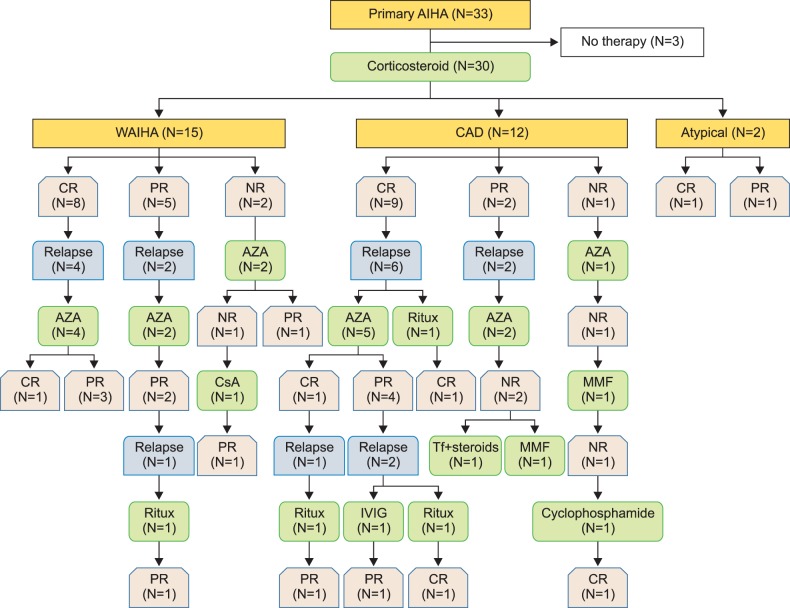Blood Res.
2016 Jun;51(2):88-94. 10.5045/br.2016.51.2.88.
Clinical characteristics and treatment outcomes of primary autoimmune hemolytic anemia: a single center study from South India
- Affiliations
-
- 1Department of Medical Oncology and Hematology, Amrita Institute of Medical Sciences, Amrita Vishwa Vidyapeetham University, Kochi, India. sraghuveerprabhu@hotmail.com
- KMID: 2309209
- DOI: http://doi.org/10.5045/br.2016.51.2.88
Abstract
- BACKGROUND
Autoimmune hemolytic anemia (AIHA) is a less recognized, potentially fatal condition. There is a scarcity of data on clinicoserological characteristics and response to therapy concerning this disease from South India.
METHODS
Data for 33 patients with primary AIHA recorded from July 2009 to June 2015 were retrospectively analyzed for clinical presentation, response to frontline therapy, durability of response, time to next treatment (TTNT), and response to second-line agents.
RESULTS
The median follow-up period was 50 months. Among 33 patients, 48% of the cases were warm autoimmune hemolytic anemia (WAIHA), 46% were cold agglutinin disease (CAD), and 6% were atypical. Three-fourth of patients had severe anemia (<8 g/dL hemoglobin [Hb]) at onset; younger patients (age <40 yr) had more severe anemia. All of the patients who required treatment received oral prednisolone at 1.5 mg/kg/d as a frontline therapy, and the response rate was 90% (62% complete response [CR] and 28% partial response [PR]). The overall response to corticosteroids in WAIHA and CAD was 87% and 92%, respectively. The median corticosteroid duration was 14 months, and 50% of the patients required second-line agents. Fourteen patients received azathioprine as a second-line agent, and 11 of these patients responded well, with half of them not requiring a third agent. Four patients developed severe infections (pneumonia, sepsis, and soft tissue abscess) and two had life-threatening venous thrombosis. One case of death was recorded.
CONCLUSION
AIHA is a heterogeneous disease that requires care by physicians experienced in treating these patients.
Keyword
MeSH Terms
Figure
Cited by 2 articles
-
Diagnosis and treatment of autoimmune hemolytic anemia: classic approach and recent advances
Sang Hyuk Park
Blood Res. 2016;51(2):69-71. doi: 10.5045/br.2016.51.2.69.Warm autoimmune hemolytic anemia: experience from a single referral center in Mexico City
Hernandez-Company Alonso, Anguiano-Alvarez Victor Manuel, Carmona Gonzalez Carlos Amir, Rodriguez-Rodriguez Sergio, Pomerantz Allan, Lopez-Karpovitch Xavier, Tuna-Aguilar Elena Juventina
Blood Res. 2017;52(1):44-49. doi: 10.5045/br.2017.52.1.44.
Reference
-
1. Barcellini W, Fattizzo B, Zaninoni A, et al. Clinical heterogeneity and predictors of outcome in primary autoimmune hemolytic anemia: a GIMEMA study of 308 patients. Blood. 2014; 124:2930–2936. PMID: 25232059.
Article2. Petz LD, Garratty G. Immune hemolytic anemias. 2nd ed. Philadelphia, PA: Churchill Livingstone;2004.3. Gehrs BC, Friedberg RC. Autoimmune hemolytic anemia. Am J Hematol. 2002; 69:258–271. PMID: 11921020.
Article4. Barcellini W, Revelli N, Imperiali FG, et al. Comparison of traditional methods and mitogen-stimulated direct antiglobulin test for detection of anti-red blood cell autoimmunity. Int J Hematol. 2010; 91:762–769. PMID: 20454945.
Article5. Zanella A, Barcellini W. Treatment of autoimmune hemolytic anemias. Haematologica. 2014; 99:1547–1554. PMID: 25271314.
Article6. Berentsen S, Ulvestad E, Gjertsen BT, et al. Rituximab for primary chronic cold agglutinin disease: a prospective study of 37 courses of therapy in 27 patients. Blood. 2004; 103:2925–2928. PMID: 15070665.
Article7. Lechner K, Jäger U. How I treat autoimmune hemolytic anemias in adults. Blood. 2010; 116:1831–1838. PMID: 20548093.
Article8. Crowther M, Chan YL, Garbett IK, Lim W, Vickers MA, Crowther MA. Evidence-based focused review of the treatment of idiopathic warm immune hemolytic anemia in adults. Blood. 2011; 118:4036–4040. PMID: 21778343.
Article9. Berentsen S, Tjønnfjord GE. Diagnosis and treatment of cold agglutinin mediated autoimmune hemolytic anemia. Blood Rev. 2012; 26:107–115. PMID: 22330255.
Article10. Naithani R, Agrawal N, Mahapatra M, Pati H, Kumar R, Choudhary VP. Autoimmune hemolytic anemia in India: clinico-hematological spectrum of 79 cases. Hematology. 2006; 11:73–76. PMID: 16522555.
Article11. Liesveld JL, Rowe JM, Lichtman MA. Variability of the erythropoietic response in autoimmune hemolytic anemia: analysis of 109 cases. Blood. 1987; 69:820–826. PMID: 3814817.
Article12. Aladjidi N, Leverger G, Leblanc T, et al. New insights into childhood autoimmune hemolytic anemia: a French national observational study of 265 children. Haematologica. 2011; 96:655–663. PMID: 21228033.
Article13. Naithani R, Agrawal N, Mahapatra M, Kumar R, Pati HP, Choudhry VP. Autoimmune hemolytic anemia in children. Pediatr Hematol Oncol. 2007; 24:309–315. PMID: 17613874.
Article14. Van De Loosdrecht AA, Hendriks DW, Blom NR, Smit JW, De Wolf JT, Vellenga E. Excessive apoptosis of bone marrow erythroblasts in a patient with autoimmune haemolytic anaemia with reticulocytopenia. Br J Haematol. 2000; 108:313–315. PMID: 10691861.
Article15. Kamesaki T, Toyotsuji T, Kajii E. Characterization of direct antiglobulin test-negative autoimmune hemolytic anemia: a study of 154 cases. Am J Hematol. 2013; 88:93–96. PMID: 23169533.
Article16. Dussadee K, Taka O, Thedsawad A, Wanachiwanawin W. Incidence and risk factors of relapses in idiopathic autoimmune hemolytic anemia. J Med Assoc Thai. 2010; 93(Suppl 1):S165–S170. PMID: 20364571.17. Jaime-Pérez JC, Rodríguez-Martínez M, Gómez-de-León A, Tarín-Arzaga L, Gómez-Almaguer D. Current approaches for the treatment of autoimmune hemolytic anemia. Arch Immunol Ther Exp (Warsz). 2013; 61:385–395. PMID: 23689532.
Article18. O'Connell N, Goodyer M, Gleeson M, et al. Successful treatment with rituximab and mycophenolate mofetil of refractory autoimmune hemolytic anemia post-hematopoietic stem cell transplant for dyskeratosis congenita due to TINF2 mutation. Pediatr Transplant. 2014; 18:E22–E24. PMID: 24168326.19. Swiecicki PL, Hegerova LT, Gertz MA. Cold agglutinin disease. Blood. 2013; 122:1114–1121. PMID: 23757733.
Article20. Berentsen S, Randen U, Vågan AM, et al. High response rate and durable remissions following fludarabine and rituximab combination therapy for chronic cold agglutinin disease. Blood. 2010; 116:3180–3184. PMID: 20634373.
Article21. Hoffman PC. Immune hemolytic anemia--selected topics. Hematology Am Soc Hematol Educ Program. 2009; 80–86. PMID: 20008185.
Article22. Otaibi ZD, Rao R, Sadashiv SK. A case of evans syndrome: a clinical condition with under-recognized thrombotic risk. J Hematol. 2015; 4:205–209.
Article
- Full Text Links
- Actions
-
Cited
- CITED
-
- Close
- Share
- Similar articles
-
- Two Cases of Autoimmune Hemolytic Anemia in Ulcerative Colitis
- A Case of Autoimmune Hemolytic Anemia Associated with Systemic Lupus Erythematosus
- Two Cases of Autoimmune Hemolytic Anemic
- A Case of Autoimmune Hemolytic Anemia after Fludarabine Treatment in Waldenstrom Macroglobulinemia
- Quetiapine Induced Autoimmune Hemolytic Anemia in a Child Patient: A Case Report


